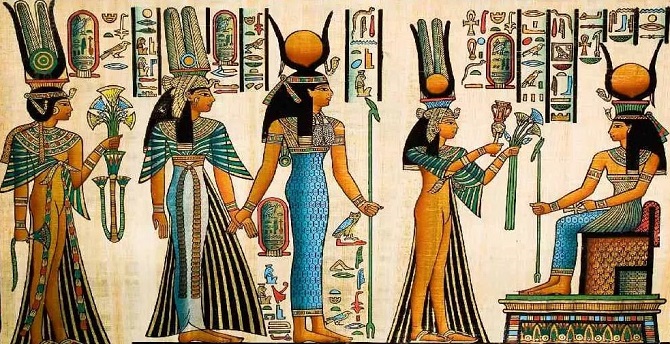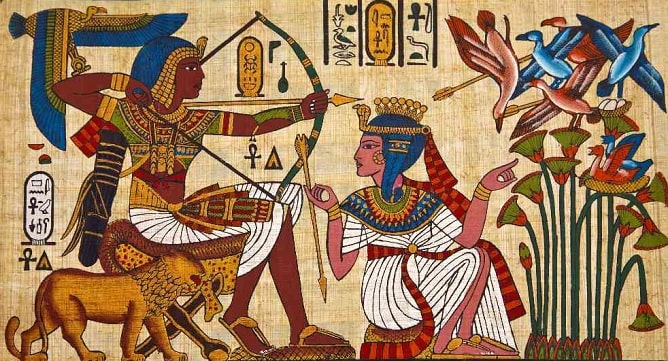Flowers in Egypt History & Meaning
Egypt is a land of great beauty, with its majestic pyramids, temples, and monuments. But it is also a land of stunning flora, with a rich and diverse floral heritage that has fascinated botanists and flower enthusiasts for centuries. From the national flower of Egypt to the ancient Egyptian flowers that adorned the temples and tombs of pharaohs, there is much to discover about the beauty and symbolism of Egyptian flowers.

Flowers of Egypt
Flowers are an essential part of Egyptian culture and history, and many of them have significant cultural and symbolic importance. Egyptian flowers include a wide range of species, from the delicate white jasmine and pink bougainvillea to the exotic blue lotus and red hibiscus. The country's warm climate and fertile soil provide ideal growing conditions for many of these flowers, making Egypt a floral paradise.
Here are some of the most important flowers of ancient Egypt and their meanings:
- Blue Lotus: Also known as Nymphaea caerulea, the Blue Lotus was one of the most important flowers of ancient Egypt. It was associated with the sun god, Ra, and was believed to have healing properties. The Blue Lotus was also used in various religious ceremonies and was a popular motif in Egyptian art.
- White Lotus: The White Lotus, or Nymphaea lotus, was another important flower in ancient Egypt. It was associated with the god of creation, Atum, and was also believed to have medicinal properties. The White Lotus was often depicted in Egyptian art, and its petals were used in perfume-making.
- Red Lotus: The Red Lotus, or Nelumbo nucifera, was a rare flower in ancient Egypt and was highly valued for its beauty and symbolism. It was associated with the god of the afterlife, Osiris, and was often used in funerary art and rituals.
- Mandrake: The Mandrake, or Mandragora officinarum, was a mystical flower in ancient Egypt and was believed to have magical properties. It was often used in love spells and was also associated with the god of fertility, Min.
- Papyrus: The Papyrus, or Cyperus papyrus, was a common plant in ancient Egypt and was used for a variety of purposes, including paper-making, boat-building, and basket-weaving. The Papyrus was also associated with the goddess of wisdom, Seshat, and was often used in religious ceremonies.
- Jasmine: The Jasmine, or Jasminum officinale, was a popular flower in ancient Egypt and was associated with love and sensuality. Its sweet fragrance was used in perfume-making, and its petals were often scattered on the beds of newlyweds.
- Marigold: The Marigold, or Tagetes erecta, was a common flower in ancient Egypt and was associated with the sun god, Ra. It was often used in religious ceremonies and was believed to have medicinal properties.
- Acacia: The Acacia, or Acacia nilotica, was a tree that was highly valued in ancient Egypt for its durable wood and medicinal properties. It was associated with the god of death and rebirth, Osiris, and its wood was often used in the construction of coffins.
.
National Flower of Egypt
The national flower of Egypt is the Egypt Lotus Flower. This stunning flower has been an important symbol in Egyptian culture for thousands of years, and it is often associated with rebirth and regeneration. The Egypt Lotus Flower is also known as the white lotus or the Egyptian water lily and is found growing in the Nile River and its tributaries. The flower has been depicted in many ancient Egyptian paintings, sculptures, and hieroglyphics, and it is still widely used in modern Egypt as a decorative motif.

Egyptian Lotus Flower Meaning
The Egyptian Lotus Flower has deep symbolic meaning in Egyptian culture. In ancient Egyptian mythology, the flower was believed to be the birthplace of the sun god, Ra. The flower also represents the cycle of life, death, and rebirth, as it closes at night and opens in the morning. The flower's ability to grow in murky, muddy waters and emerge pristine and pure symbolizes the idea of rising above challenges and obstacles to achieve greatness.
Ancient Egyptian Flowers
The ancient Egyptians were passionate about flowers and used them extensively in their art, architecture, and religious ceremonies. Many of the flowers they used have significant symbolism and meaning. For example, the blue lotus was associated with the sun and rebirth, the red hibiscus with beauty and youth, and the white jasmine with love and sensuality. The ancient Egyptians also used flowers as offerings to their gods and as decorations for their tombs and temples.
Flower of Egypt
While the Egypt Lotus Flower is the most famous flower of Egypt, there are many other beautiful flowers that are found throughout the country. The Bougainvillea is a common sight in Egyptian gardens and is prized for its bright pink and purple blooms. The Hibiscus is also a popular flower in Egypt and is often used in traditional medicine to treat various ailments. Other flowers commonly found in Egypt include the Jasmine, Chrysanthemum, and Marigold.
Egyptian Lotus Flower Symbol
The Egyptian Lotus Flower is a powerful symbol in Egyptian culture and is still used in many modern contexts. The flower's association with rebirth and regeneration makes it a popular choice for tattoos, jewelry, and other decorative items. The flower is also commonly used in Egyptian weddings, where it symbolizes the couple's journey of growth and transformation together. Egyptian flowers are a beautiful and essential part of the country's cultural heritage. From the national flower of Egypt to the ancient Egyptian flowers that adorned the tombs and temples of pharaohs, these flowers have deep symbolic meaning and significance. The Egypt Lotus Flower, with its association with rebirth and regeneration, is a powerful symbol that continues to inspire people to this day. Whether you are a flower enthusiast, a botanist, or just someone who appreciates the beauty of nature, exploring the floral heritage of Egypt.
Best Egypt Private Tours 2026
| Tour | Itinerary | Price |
|---|---|---|
| Egypt Solar Eclipse Tour | 9 Days | $ 6895 |
| Egypt and Kenya Tours | 15 Days | $ 6250 |
| Egypt and Dubai Tours | 8 Days | $ 999 |
| Turkey and Egypt Tours | 8 Days | $ 1060 |
| Egypt and Petra Tours | 12 Days | $ 2255 |
| Egypt and Morocco Tours | 15 Days | $ 3220 |
| Egypt Tanzania Tour | 14 Days | $ 6275 |
| Egypt and Holy Land Tours | 15 Days | $ 4100 |
| Egypt and Greece Tours | 14 Days | $ 3380 |
| Nile Cruise and Stay | 8 Days | $ 2210 |
| Cairo and Nile Cruise Package | 7 Days | $ 1375 |
| Egypt Pyramid Tour Packages | 8 Days | $ 1680 |
| 5 Star Egypt Tours | 8 Days | $ 1680 |
| Egypt Overland Tours | 8 Days | $ 1355 |
| Egyptologist Tours | 7 Days | $ 1335 |


